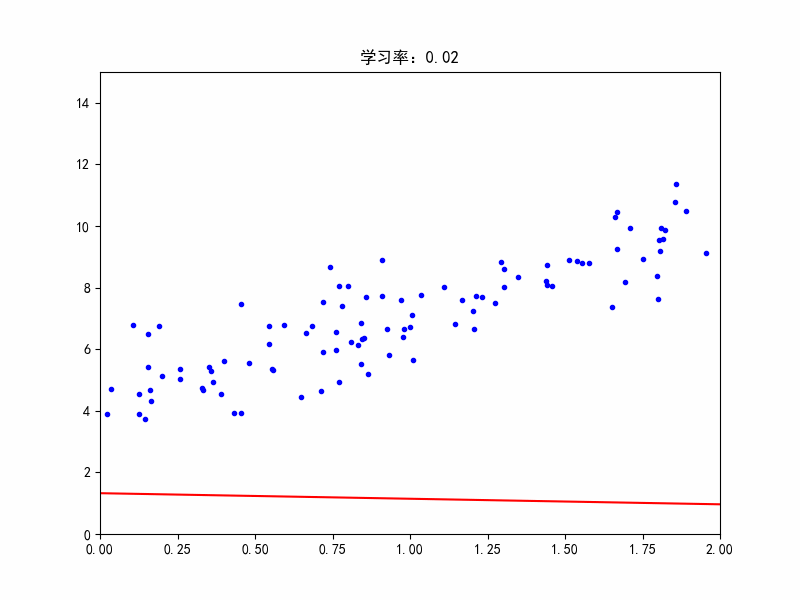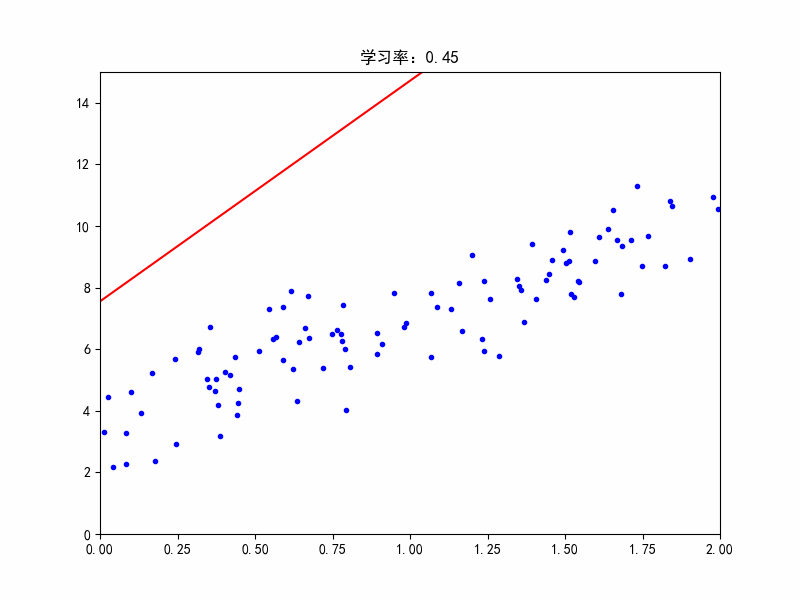机器学习过程中经常需要可视化,有助于加强对模型和参数的理解。
下面对梯度下降过程进行动图演示,可以修改不同的学习率,观看效果。
|
1
2
3
4
5
6
7
8
9
10
11
12
13
14
15
16
17
18
19
20
21
22
23
24
25
26
27
28
29
30
31
32
33
34
35
36
37
38
39
|
import numpy as npimport matplotlib.pyplot as pltfrom IPython import displayX = 2*np.random.rand(100,1)y = 4+3*X+np.random.randn(100,1) # randn正态分布X_b = np.c_[np.ones((100,1)),X] # c_行数相等,左右拼接eta = 0.1 # 学习率n_iter = 1000 # 迭代次数m = 100 # 样本点个数theta = np.random.randn(2,1) # 参数初始值plt.figure(figsize=(8,6))mngr = plt.get_current_fig_manager() # 获取当前figure managermngr.window.wm_geometry("+520+520") # 调整窗口在屏幕上弹出的位置,注意写在打开交互模式之前# 上面固定窗口,方便screentogif定位录制,只会这种弱弱的方法plt.ion()# 打开交互模式plt.rcParams["font.sans-serif"] = "SimHei"# 消除中文乱码for iter in range(n_iter): plt.cla() # 清除原图像 gradients = 2/m*X_b.T.dot(X_b.dot(theta)-y) theta = theta - eta*gradients X_new = np.array([[0],[2]]) X_new_b = np.c_[np.ones((2,1)),X_new] y_pred = X_new_b.dot(theta) plt.axis([0,2,0,15]) plt.plot(X,y,"b.") plt.plot(X_new,y_pred,"r-") plt.title("学习率:{:.2f}".format(eta)) plt.pause(0.3) # 暂停一会 display.clear_output(wait=True)# 刷新图像plt.ioff()# 关闭交互模式 plt.show() |

学习率:0.1,较合适

学习率:0.02,收敛变慢了

学习率:0.45,在最佳参数附近震荡

学习率:0.5,不收敛
到此这篇关于浅谈matplotlib 绘制梯度下降求解过程的文章就介绍到这了,更多相关matplotlib 梯度下降内容请搜索服务器之家以前的文章或继续浏览下面的相关文章希望大家以后多多支持服务器之家!
原文链接:https://blog.csdn.net/qq_21201267/article/details/107270721










